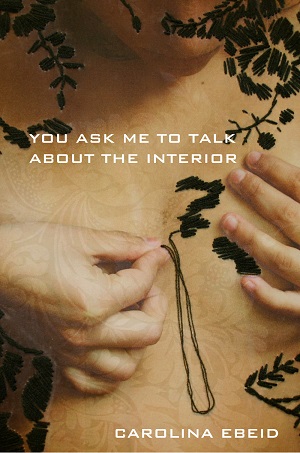 You Ask Me To Talk About the Interior, by Carolina Ebeid
You Ask Me To Talk About the Interior, by Carolina Ebeid
It is perhaps most difficult to see beauty when it lives in and around something horrid. But the focus of vision does not preclude it from existing. A pristine sky is unconcerned with tragedy and violence beneath it, and there is a strength in character, I think, in having the capacity to recognize both simultaneously. That strength flows through You Ask Me To Talk About the Interior, a poetry collection written by Carolina Ebeid, in abundance. This book is a fundamentally intense and vivid exploration of the universe we exist in and distort for ourselves, and one that embraces the echoing dualities of our lives not as contradictions but as ends of cyclical spectrums.
The poetry of this collection is not beholden to any one style. The traditional mixes with the experimental as if the words are trying on different outfits. Some poems exist in the tightest, most suffocating confines, while others sprawl out and leave luxurious gaps between their limbs. The deliberate control over spacing and line breaks is regularly impressive throughout the book and, as one would expect, this allows for endless reengagement. The greatest risk in this situation for a poetry collection is that the poems may end up feeling disorganized and hastily slapped together to fill space. But Ebeid’s work handles any potential worry along such lines by utilizing a powerful and consistent tonal and thematic undercurrent. Almost every poem utilizes evocative natural imagery and the duality beauty and grief. This experience grips the reader in an intensely emotional way, forcing us to feel everything. This is not a drug meant to banish pain or a device meant to torture. The poetry embraces life in its sublime extremities.
In order to accomplish these sensations, Ebeid juxtaposes the almost unnervingly intimate with the sensory overload of the vast. The various speakers of the collection are skeptical mothers, witnesses and victims of carnage, hopeful dreamers, and more, not to mention amalgams of all different types.
When I fell in love, I spoke / as a child & and dressed as a child
I lifted a lavender / heart, not the form inside / your rib cage
Again and again we find a contradiction-defying inclusion of innocence and experience as the poems move at random through time. Whole lives are incorporated in this way, especially if one imagines speakers moving from poem to poem. This collection, I feel, will get no small amount of recognition for its laments and remembrances, and rightly so. But it includes much more than passive, negative reaction, and is all the stronger for it. The full gamut of emotions is at play here and there is no shortage of critique. Hypocrisy and inaction are exposed for the complicity they are, and traditional systems of comfort or explanation are challenged.
rings of white gold bring attention / bring persistence bring faith / in the persistence of what seems / most fated to die says the book
Aside from the sheer richness of the wordplay, I think one of my favorite aspects of this collection is its recognition of poetry as an interactive experience. The use of varied structure and minimalist language provide the groundwork, allowing the reader to unpack and fill space with her own perspective. But the poems will, at times, even directly engage the reader. One stanza from the last poem in the collection reads like this:
reader, / I am emptied of me & you / of you / yourself keeps swarming out / until we are standing in a wide pool
Normally, this kind of direct address is frowned upon as lacking subtlety or wit. But I think the poetry here more than makes its own case. The speaker wants you to remember that you are reading. Just as you are encouraged to embrace the good and the bad, the beautiful and the tragic, and the full extent of nature and humanity, you are also reminded that you are both inside and outside of the work itself. It leaves the reader with a responsibility to carry this perspective with them beyond the closing of the book. One could even read that stanza in a challenge. Is the pool blood or some other essential? Now that the speaker has emptied herself of herself, do you not have the responsibility to do the same? The swarming out certainly indicates that the process has begun.
I highly recommend this collection for anyone who seeks, if you will pardon the cliché, food for thought. The poetry here is infinitely digestible. It is the kind of literature that you can and should keep reengaging with after thorough bouts of contemplation. It operates on the vividly physical and the imposingly metaphysical, asking deeply complicated questions. But it does not shrink from its own challenges. It hints at origin points of answers and lays bare its suspicions.
You Ask Me To Talk About the Interior is available now through Noemi Press.



